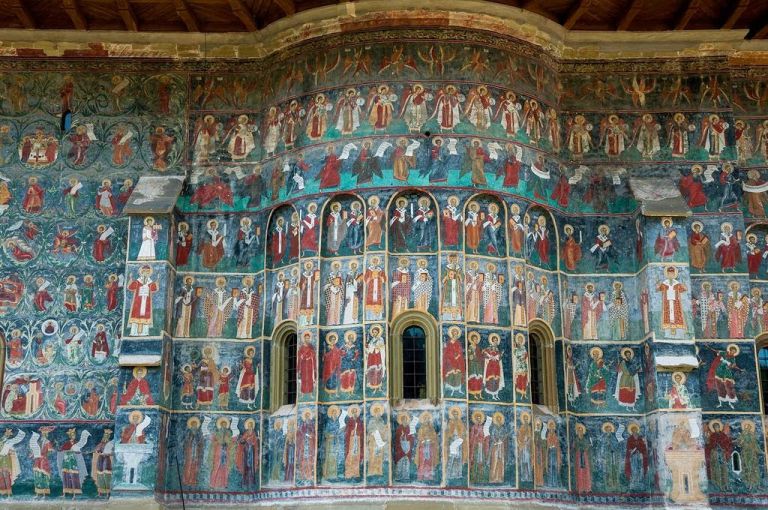The frescoes have remained almost unaffected by time and atmospheric conditions
In Romania, several monasteries hundreds of years old, as well as their main churches, are painted on the outside of the temples. Considering the technology of the creation of the frescoes, it is surprising that they have survived, unaffected neither by time nor by atmospheric conditions.
Perhaps the most famous of these monasteries is Voronets. But he is not the only one. The Humor Monastery, built in 1530, is also dotted with frescoes on the outside. They are not as preserved as those in Voronets, but they look impressive. In 1488, the Moldavian prince Stefan the Great founded Voronets as a sign of gratitude to the hermit Daniil, who encouraged him to fight against the Ottomans in Wallachia. The monastery was built between May 24 and September 14, 1488. The church was erected over a period of about four months, and in 1547, during the reign of Metropolitan Grigore Rosca, the vestibule was added, which was also painted on the outside. Since its creation, the monastery has been inhabited by monks. Monastic life was interrupted in 1758 after the annexation of the Bukovina region to the Habsburg Empire. Then Voronets did not function, and the cells of the monks were destroyed. In 1991, the activity of the monastery was renewed by nuns, headed by the abbess Irina Pantescu Stavrofora.
Murals on the outer walls of the temple
The frescoes on the walls of the Voronets monastery are distinguished by the fact that the painter depicted strong, memorable figures that do not have the aristocracy of the images from the Arbora monastery, for example, but have very realistic features, as if they were people of the people.
The Voronets Monastery is called the Sistine Chapel of the Orient, because of the large fresco on the western facade – “The Day of Judgment”. She amazes with the finesse with which she presents the most apocalyptic picture in the Moldavian open-air gallery. Unlike Michelangelo’s original, there is no huddle of half-naked muscular bodies, no tumult in the face of impending inevitability. This impressive picture is executed compositionally in five registers. In the main part is God the Father, and on both sides of him are depicted the zodiac signs.
The Moldovitza Monastery was built in 1532 as a symbolic protective barrier against the attacks of the Turks. It was built by the voivode Petr Rares, an illegitimate son of Stefan III the Great, by whose order the Voronets monastery was built. The frescoes were painted by Thomas of Suceava in 1537. They are filled with yellow accents and are well preserved. The predominantly yellow-blue paintings on its exterior represent recurring themes in Christian Orthodox art: a procession of saints leads to the Virgin enthroned with the Child in her lap above the narrow east window; The “Tree of Isaiah” springs from a recumbent Isaiah at the foot of the wall to marshal the progenitor of Christ around the Holy Family; the “Siege of Constantinople” commemorates the Virgin’s intervention in saving the city of Constantinople from a Persian attack in AD 626. (although the siege depicted is more the Fall of Constantinople in 1453).
High arches open the porch to the outside and daylight. In it the “Doomsday” covers the entire surface of the western wall with its river of fire and its image of the sea giving its dead to judgment. Moldovi and Humor are the last churches built with an open porch, a crypt above the tomb, and with Gothic-style windows and doors.
In 1585, the Sucevitsa monastery was built, the outer walls of which were also decorated with frescoes. Like the other monasteries, Sucevitsa combines elements of Byzantine and Gothic architecture, and the frescoes use scenes from the Old and New Testaments. The architecture of the church contains both Byzantine and Gothic elements and some elements characteristic of other painted churches in Northern Moldova. Both the inner and outer walls are covered with frescoes that have great artistic value and depict biblical episodes from the Old and New Testaments. The paintings date from around 1601, making Sucevica one of the last monasteries decorated in the famous Moldavian style of exterior paintings.
The courtyard of the monastic ensemble is almost square (100 by 104 meters) and is surrounded by high (6 m), wide (3 m) walls. There are several other defensive structures in the ensemble, including four towers (one at each corner). Sucevitsa was a princely residence as well as a fortified monastery. The thick walls now house a museum that presents an extraordinary collection of historical and artistic objects. The lids of the tombs of Jeremiah and Simeon Movila – rich portraits embroidered with silver threads – together with church silverware, books and illuminated manuscripts, bear eloquent testimony to the importance of Sucevitsa first as a manuscript workshop and then as a printing house.









